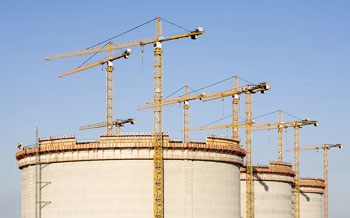Global Research Update: High Challenge Storage Protection
 On June 27 the Research Foundation and NFPA’s international operations department presented a seminar on research to address high challenge storage protection for aerosols, lithium batteries, flammable and combustible liquids, automated storage and retrieval systems, and others. 110 attendees from 17 nations attended this event in Paris, France to explore the latest global research and emerging trends on storage protection.
On June 27 the Research Foundation and NFPA’s international operations department presented a seminar on research to address high challenge storage protection for aerosols, lithium batteries, flammable and combustible liquids, automated storage and retrieval systems, and others. 110 attendees from 17 nations attended this event in Paris, France to explore the latest global research and emerging trends on storage protection.
“Many of today’s products including aerosols, lithium-ion batteries, and flammable and combustible liquids increasingly pose storage challenges in warehouses around the world,” said Kathleen Almand, executive director of the Fire Protection Research Foundation. The featured presentations from insurance industry and global property owners discussed a variety of warehousing challenges and current understandings, as well as results from the most recent full-scale fire tests in the occurrence and control of potential fire incidents.
Below is a short summary for each of the highlighted presentations. A complete set of the presentations discussed during the conference can be found on the NFPA website.
| Large-Scale Fire Sprinkler Tests With The AutoStore© Compact Storage System |
| By Magnus Arvidson*, Henry Persson and Maria Hjohlman Department of Fire Technology , SP Technical Research Institute of Sweden Research results on fire tests for a compact storage bin system for warehousing was presented. These stackable small bins (0.65x45x33 m3) made from HDPE (High Density Polyethylene) and PP (Polypropylene) are capable of storing up to 30-kg (66-lbs) each. According to the investigators up to 70,000 of these bins can be stacked up to 5.3-m (17-ft) high in a warehouse configuration. Large-scale fire tests at the UL facilities demonstrated the slow fire growth rate that was observed in previous free-burn fire tests. According to the study “The number of activated sprinklers and the average steel beam temperature at the ceiling were well below what was determined as the maximum allowed“. The bin stack stayed stable during the fire tests. Overhead sprinklers in combination with manual fire fighting with foam nozzles was considered effective. |
| Pallet Materials And Their Impact On Fire Protection Storage |
| By Kerry M. Bell, Principal Engineer Fire Sprinkler and Pump Equipment UL LLC
It was highlighted that the sprinkler system design criteria in NFPA 13 is based on the assumption that wood pallets are applied in any type of storage configuration. While plastic pallets listed in accordance with ANSI/UL 2335 demonstrate a similar heat release rate compared to wood pallets, non fire-retardant plastic pallets can create a much higher heat release rate and, as a result create a “much greater fire challenge to a sprinkler system compared to wood pallets”. |
| Evaluating Fire Protection For Automatic Storage And Retrieval Systems |
| BY Benjamin Ditch,
Senior Research Engineer FM Global
Fully Automatic Storage and Retrieval Systems, ASRS, are characterized by their relatively high storage density, which in turn affects flue space widths and aisle widths. Despite obvious differences to standard racks, current design guidelines are based primarily on testing with standard racks. Fire tests on a double row 7.6-m (25-ft) tall rack with 672 containers showed that ASRS and standard racks exhibit similar fire growth rates. But when it comes to fire suppression ASRS increases the water demand due to the limited water penetration. Perhaps most importantly, it was concluded that ceiling sprinkler protection for standard racks couldn’t be applied. |
| Large Storage of New and Used Lithium-Based Batteries |
| By Guy Marlair and Diego Lisbona, Ineris
Lithium-based batteries are commonly used in all kind of products ranging from watches to laptops and nowadays even in cars. The continuously expanding applications of these types of batteries in combination with issues for recyclability of end-of-use batteries, require increased warehousing storage capacity. Lithium based batteries include lithium-metal batteries and lithium-ion batteries. Hazards associated with lithium metal batteries include highly flammable hydrogen gas release, internal short-circuit, exothermic activity (thermal runaway), and oxidation from organic solvents. Some of the lithium-ion batteries related hazards include limited temperature and voltage stabilities and the potential for thermal runaway. A comprehensive list of fire incidents and type of storage configurations are presented that demonstrate the potential for these hazards and the risks that are associated with storing these batteries. Several fire protection methods were reviewed in light of their effectiveness. It was emphasized that much needs to be done to create a better understanding in specifying the type of fire protection methods depending on the type of storage configurations and battery types used. |
| Flammable And Combustible Liquid Storage Challenges |
| By Christopher Wieczorek, FM Global and David Nugent, Valspar
Research results on an understanding of liquid pool fires and the behavior of Nonmetallic Intermediate Bulk Containers (IBC’s) in a fire incident were presented. These types of containers have a capacity of 450 – 3000 liters (119 – 793 gallons) and can be made of various materials, such as metals, plastic, composite materials, and corrugated cardboard. Presentation included the hazards from potential pool fires of various flammable and combustible liquids stored in these IBC’s, as well as the required fire protection means of pool fires including the failure characteristics of non-approved IBC’s in a rack storage configuration or palletized storage. It was recommended to use in-rack sprinklers in order to stop IBC failure and control local pool fires and ceiling sprinklers to control larger pool fires. It was emphasized that fire originating from empty IBC’s is a greater hazard than from pool fires or single IBC fires. More research to understand the fire dynamics is in process. New guidance options under DS 7-29 were given on how to protect various liquids in specific types of IBC’s (composite, bag-in-box, empty). |
| Flammable And Combustible Liquids in Ordinary, Non-listed, Nonmetallic Intermediate Bulk Containers |
| By David P. Nugent, Valspar Corporation
An industry perspective on the use of non-listed, non-metallic IBC’s in combination with various blends of flammable and combustible liquids was presented. Test results from Phase I, ‘Ignition and Combustion Properties of Various Aqueous Organic Solutions,’ of this two-phase research was discussed. Phase II will include large scale sprinklered fire tests to evaluate appropriate fire protection using sprinklers. For these first sets of tests thirty aqueous blends of flammable and combustible solvents were tested for their flash point, fire point, and heat release rate. The test results were tabulated and graphed. Some of the liquids tested were Acetone, MEK, Propanol, Butanol, various acids, and EEGE (solvent used for inks, dyes, resins, lacquers, etc.). |
| Fire And Explosions At An Aerosol Warehouse |
| By Graham Atkinson, Health and Safety Laboratory
This fire reconstruction and analysis was performed for a distribution warehouse with approx. 50% aerosol anti-perspirants alcohols and LPGs on 4000 pallets and the remainder of the storage volume with low hazard goods, such as shampoos, hair colors on an additional 4000 pallets. It was concluded, “even in large buildings escape times can be as low as 100 seconds. Sprinklers may provide valuable reductions in risk. Research on the behavior of palletized aerosols in hot gas flows is needed.” |
| High Volume Low Speed (HVLS) Fans And Sprinkler Performance |
| By Garner Palenske, AON
Test results of multi-phase full-scale fire tests performed at the UL test facilities in the years 2008 to 2010 were presented. The study evaluated the impact of HVLS fans on fire dynamics and required fire protection (sprinkler configurations) to control or suppress fires. Various storage configurations (rack heights) and sprinkler types and configurations (CMDA, ESFR) were tested and evaluated towards their effectiveness. Suggestions were given to address some of the concerns arising from the use of HVLS fans. |




